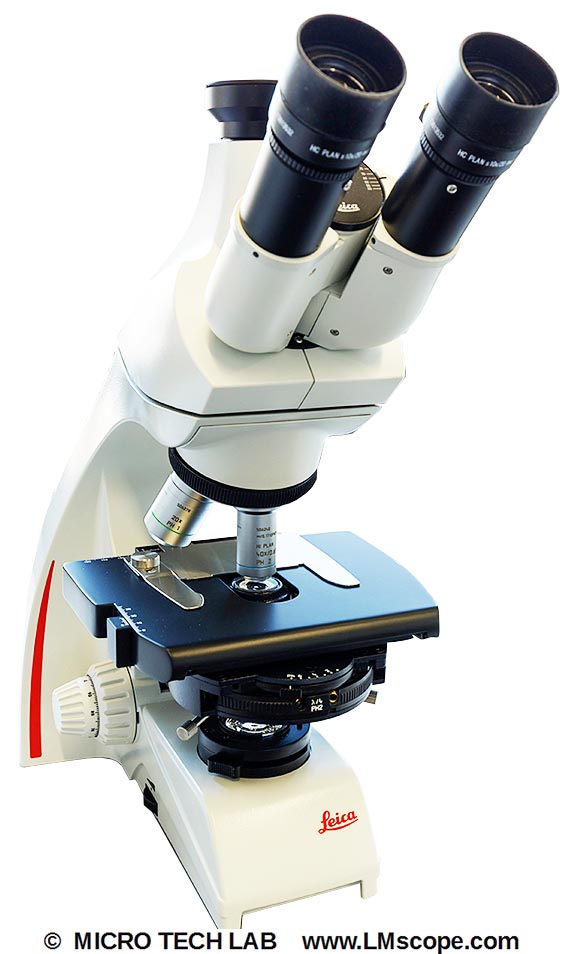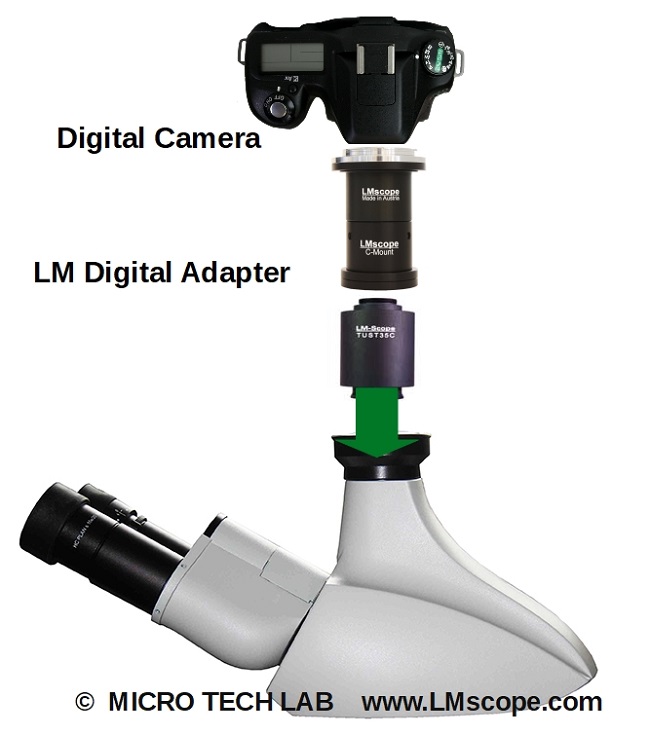

The Leica DM500 and DM750 – educational microscopes for photomicrography
Leica’s DM500 and DM750 microscopes were designed specifically for medically related educational environments, such as human medicine, veterinary medicine and dentistry. As the successor to Leica’s CME – another training microscope – the DM750 features a quite robust construction (9 kg). Both the DM500 and the DM750 offer bright field, dark field and phase contrast capabilities. Using our LM digital adapters, all current DSLR and system cameras can be attached to the DM500 and DM750 models quickly and easily. This combination enables the use of state-of-the-art camera technology to achieve exceptional digital photo documentation.

With its pre-centred, pre-focussed condenser, tube-integrated eyepieces and additional viewing tubes, the DM500 is particularly suitable for beginners.
The DM750 can also be upgraded extensively (Koehler field diaphragm, phase turret condenser for bright field and phase contrast, etc.) The four-position nosepiece (optional five-position nosepiece on the DM750) can accommodate the Leica objectives (Plan FOV18, HI Plan FOV20 and HI Plan Phase FOV20), all of which are renowned for their quality. Aside from the fact that the specimen stage has a wear-resistant surface, a new additive named AGTREATTM helps reduce the spread of microbes on the instrument’s surfaces.
The microscopes of this series exclusively use LEDs for illumination; no halogen alternative is available.
Leica offers a large selection of rotatable tubes for its DM500 and DM750 microscopes.
- 45° EZ tube
- 30° EZ tube
- 45° binocular
- 30° binocular
- 45° trinocular
- 30° trinocular
EZTUBETM features:
- Eyepiece lenses integrated with the tubes prevent loss
- Preset dioptre adjustments eliminate the risk of incorrectly setting the dioptres manually
- Additional viewing tubes are also available
Especially when it comes to photomicrography applications, it is interesting to note that the microscope also supports cameras other than those manufactured by Leica (such as the Leica ICC50W). With our LM digital adapters, DSLR and system cameras can be attached in just a few simple and quick steps.

Photography:
Fitting the microscope to digital single-lens reflex (DSLR), mirrorless interchangeable-lens cameras (MILC ), digital single-lens mirrorless (DSLM) or C-mount cameras is easy with our LM digital SLR adapters, which feature a plan achromatic optical system. Our products make it possible to capture top-quality microscope images. To help you select the adapter that is right for your camera, we have set up an online configurator on our website. You can also email us – ideally with attached photographs of your microscope.
Modern DSLR and single-lens mirrorless (DSLM) offer the latest technology and are generally very well suited for microscopy applications. Most of them can be controlled remotely via PC/Mac. Because of their high sales volumes, they offer an excellent price/performance ratio compared to special-purpose microscope cameras.
Features of top DSLR and single-lens mirrorless cameras (DSLM):
- Large, powerful full-frame sensors (36 x 24 mm)
- Sensor resolution of 61 megapixels or 240 megapixels with Pixel Shift technology
- High light sensitivity (ISO 400,000+)
- Extensive dynamic range (up to 15 aperture stops/f-stops)
- Short exposure times (1/8000 second) up to 1/32,000 seconds using the digital shutter
- 4K Ultra HD or 8K Ultra HD video function
- Live video capture on external monitors in ultra HD quality
In most cases, these cameras are significantly more powerful than microscope cameras with smaller sensors (1/2" or 2/3"). On our website you will find our current camera recommendations and a camera ranking which is specifically tailored to microscopy applications.
New LM Digital Adapter for: Sony Alpha 9 III / Nikon Z9 / Nikon Z8 / Sony Alpha 7R V / Sony Alpha 1 II / Sony Alpha 1 / Sony Alpha 9 II (ILCE-9M2) / Sony FX3 Cinema Line / Sony Alpha 9 / Nikon D6 / Canon EOS R3 / Canon EOS R6 Mark II / Canon EOS R8 / Sony Alpha 7R IV / Canon EOS R5 II / Nikon Z6III / Canon EOS R5 / Sony Alpha 7S II / Sony Alpha 7S III / Sony Alpha 7R III / Canon EOS R6 / Nikon Z6 / Nikon Z6II / Sony Alpha 7R II / Nikon Z7 / Nikon Z7II / Canon EOS R / Canon EOS Ra (Astro) / Nikon Z5 / Sony Alpha 7C / Canon EOS RP / Sony Alpha 7S / Canon EOS R7 / Leica SL2-S / Canon EOS R10 / Nikon Z50 II / Canon EOS 1D X Mark III / Nikon Z50 / Nikon Z30 / Nikon Z fc / Nikon D850 / Canon EOS 1D X Mark II / Nikon D780 / Olympus OM-1 / Sony Alpha 7III / Olympus OM-D E-M1 Mark III / Canon EOS R100 / Sony Alpha 6700 / Nikon D5 / Sony Alpha 6600 / Fujifilm X-H2S / Fujifilm X-S10 / Fujifilm X-E4 / Fujifilm X-Pro3 / Olympus OM-D E-M1X / Sony Alpha 6400 / Sony Alpha 6100 / Sony ZV-E10 / Canon EOS 1D X / Nikon D4s / Olympus OM-D E-M5 III / Canon EOS 90D / Canon EOS 5D Mark IV / Nikon D4 / Nikon D750 / Canon EOS 6D Mark II / Fujifilm X-T5 / Fujifilm X-T4 / Fujifilm X-T3 / Sony Alpha 6300 / Sony Alpha 6500 / Nikon D500 / Nikon D810 / Nikon D800 / Canon EOS M6 Mark II / Nikon D800E / Nikon Df / Panasonic Lumix DC-G9 / Nikon D610 / Nikon D600 / Canon EOS 250D / Canon EOS 850D / Rebel T8i / Canon EOS 6D / Sony Alpha 99 II (SLT-A99 II) / Canon EOS M200 / Canon EOS 5DS R ( without low-pass filter) / Olympus OM-D E-M1 Mark II / Canon EOS 80D / Canon EOS M50 Mark II / Canon EOS 5DS / Canon EOS M50 / Sony Alpha 77 II / Canon EOS 70D / Nikon D7200 / Pentax K-1 Mark II / Canon EOS 200D / Canon EOS 800D / Rebel T7i / Canon EOS 77D / Canon EOS 5D Mark III / Canon EOS 60D / Sony Alpha 7R /